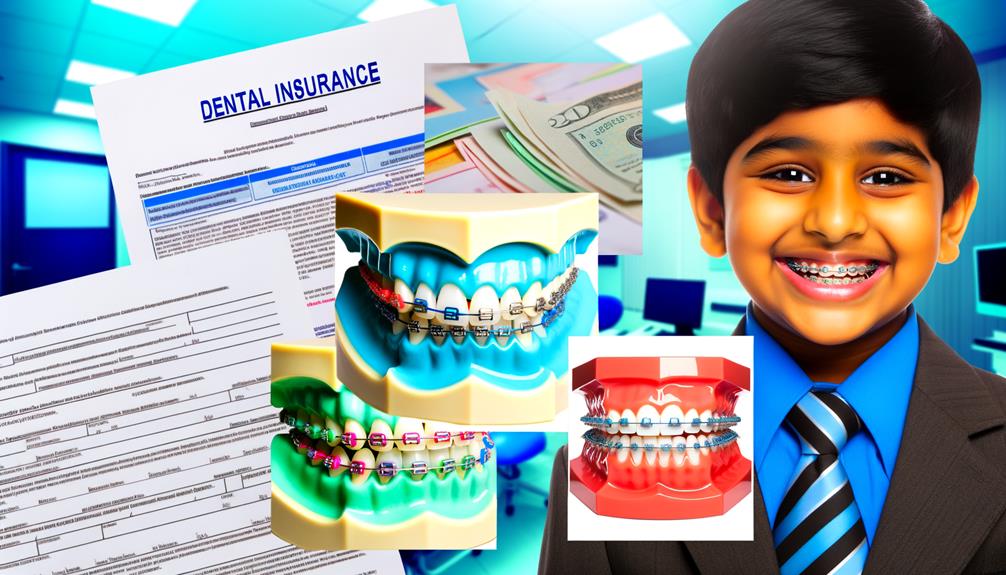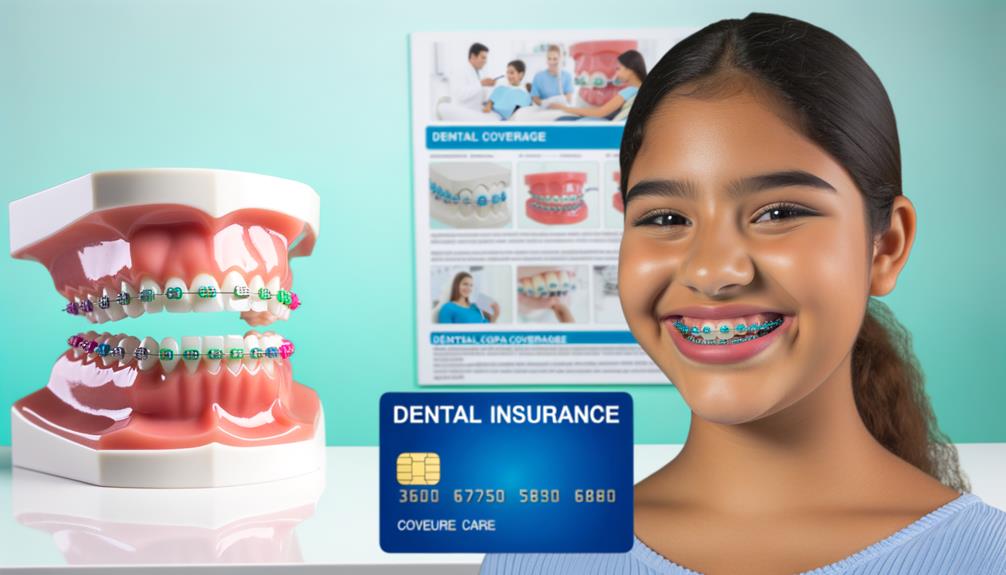Dental insurance can be quite beneficial when it comes to braces, typically covering 50% to 80% of your treatment costs. However, coverage isn't universal; it often depends on your specific plan and whether you meet certain eligibility criteria. Lifetime maximum benefits may apply, meaning there can be limits on how much your insurance will pay over time. Keep in mind that not all types of braces are covered, and age restrictions might impact your eligibility. Understanding these nuances is essential for maximizing your benefits, and there's more to evaluate that could influence your overall experience.
Key Takeaways
- Dental insurance typically covers 50% to 80% of braces costs, depending on the plan and specific coverage details.
- Lifetime maximum benefits often apply specifically to orthodontic treatments, limiting total reimbursement available.
- Eligibility for coverage may vary based on age, with some plans restricting benefits for adults or specific age groups.
- Not all types of braces are covered by dental insurance; reviewing policy specifics is essential before starting treatment.
- Engaging with your insurance provider can clarify benefits and maximize coverage for orthodontic treatments.
Understanding Dental Insurance Basics

Understanding dental insurance can seem overwhelming, but getting a grasp on the basics is necessary for making informed decisions about your oral health. Start by familiarizing yourself with essential dental insurance terminology, like premiums, deductibles, and copayments. These terms are the foundation of your coverage and can greatly impact your costs. Additionally, understanding the AMA's role in healthcare can provide insights into how insurance policies may influence access to dental care.
When you're considering different plans, a policy comparison becomes important. Look at what each plan covers, especially concerning braces, as not all policies provide the same level of benefits. Some may cover a portion of orthodontic treatments while others might exclude them altogether. Understanding the specifics of each plan can help you identify which offers the best value for your needs.
You'll also want to pay attention to the network of providers associated with each insurance plan. If you have a preferred orthodontist, verify they're within the network to avoid higher out-of-pocket expenses. By grasping these fundamental concepts and doing a thorough policy comparison, you'll be well-equipped to make choices that not only benefit your oral health but also align with your financial goals.
Types of Dental Insurance Plans
When exploring dental insurance options, it's important to recognize the different types of plans available. Each plan type has unique features that can greatly impact your coverage for braces. For instance, understanding navigating the grocery aisle can help you make smarter choices in selecting the right dental plan. PPO plans are popular due to their flexibility. They allow you to visit a wide network of dentists and specialists, often without needing a referral. These plans typically cover a larger portion of orthodontic treatments, making them an attractive choice for families considering braces.
On the other hand, HMO options provide a more structured approach. You'll need to choose a primary care dentist and get referrals for specialists. While these plans may have lower premiums, they often come with limitations on covered services, including orthodontics.
Indemnity insurance is another type that offers maximum flexibility. You pay upfront for your treatment and then submit a claim for reimbursement. This can be beneficial if you prefer a specific orthodontist.
Lastly, discount programs aren't insurance but can provide reduced fees for dental services. They're worth considering if you're looking for immediate savings without the commitment of a traditional plan. Understanding these options will help you make an informed decision about your dental insurance.
Coverage for Orthodontic Treatments

Coverage for orthodontic treatments can vary considerably depending on your dental insurance plan. Most plans provide some level of coverage for braces, but the specifics can differ widely. Typically, you'll find that insurance covers a percentage of the braces costs, often ranging between 50% to 80%, but this can be subject to a lifetime maximum benefit. Understanding your orthodontic eligibility is essential, as some plans only cover treatment for children, while others extend benefits to adults as well. Additionally, it's important to recognize that factors such as race and socioeconomic status can influence access to orthodontic care, which underscores the significance of understanding identity's impact on healthcare practices.
Before committing to braces, it's wise to thoroughly review your policy. Look for clauses related to waiting periods, and confirm that your chosen orthodontist is within your plan's network to maximize your benefits. Additionally, consider any deductibles or co-pays that may apply, as these can impact your overall out-of-pocket expenses.
You might discover that some plans provide discounts for orthodontic treatment when you meet specific criteria, enhancing your access to necessary care. Ultimately, understanding your coverage details will empower you to make informed decisions about your orthodontic journey and help you achieve the beautiful smile you deserve without financial strain.
Limitations and Exclusions
While many dental insurance plans offer some level of coverage for braces, it's important to be aware of the limitations and exclusions that may apply. One common limitation involves orthodontic eligibility, as some plans specify age restrictions or require that treatment begins before a certain age. If you or your child don't meet these criteria, your coverage options may be considerably reduced. Additionally, coverage for orthodontic treatments can vary greatly, with some plans having specific policies on therapeutic exercises that may indirectly affect overall dental health.
Moreover, treatment timelines can also affect your benefits. Many insurance plans impose maximum limits on the duration of coverage for orthodontic treatment. If your treatment extends beyond this period due to unforeseen complications or adjustments, you might find yourself responsible for additional costs.
Additionally, not all types of braces are covered. For instance, some plans only cover traditional metal braces and exclude options like ceramic or lingual braces, which can be more aesthetically pleasing but pricier.
Tips for Maximizing Benefits

To guarantee you get the most out of your dental insurance for braces, it's crucial to understand your plan's specifics and actively engage with your provider. With healthcare innovation becoming increasingly important, understanding your coverage can lead to better health outcomes and financial management, much like the impact of trailblazing leaders in the field, such as the first female cardiologist to lead The Permanente Medical Group, who emphasizes the significance of informed decision-making in healthcare healthcare innovation. Start by reviewing your policy documents, paying particular attention to coverage limits, waiting periods, and any exclusions. Knowing what's covered can help you anticipate out-of-pocket costs.
Don't hesitate to reach out to your insurance provider for clarification during insurance negotiations. They can provide insights on maximizing your benefits, including any necessary pre-approvals or documentation. If your plan has a flexible spending account (FSA) or health savings account (HSA), consider utilizing these for orthodontic financing, which can greatly reduce your overall expenses.
It's also wise to consult with your orthodontist's office about payment plans and potential discounts for upfront payments. Many offices are experienced in dealing with insurance providers and can assist you in maneuvering the complexities of your coverage.
Frequently Asked Questions
How Do I Choose the Right Dental Insurance for Braces?
When choosing the right dental insurance for braces, you'll want to carefully examine coverage limits and policy exclusions. Look for plans that offer sufficient coverage for orthodontic treatments, as some policies may not cover adult braces or have age restrictions. Additionally, check for waiting periods that might delay your benefits. By understanding these details, you can find a plan that meets your needs and helps you achieve that perfect smile with confidence.
Can I Use My Dental Insurance With Any Orthodontist?
You can typically use your dental insurance with any orthodontist, but it's best to check if they're in-network providers. When you choose an orthodontist that's part of your plan, you'll often receive more extensive benefits and lower out-of-pocket costs. Orthodontic specialists usually have the expertise needed for braces, so finding one who accepts your insurance can make your treatment more affordable and efficient, helping you achieve that smile you desire.
What Age Is Best for Children to Get Braces?
The best age for children to get braces typically falls between 9 and 14 years. This period allows for early intervention, as dental structures are still developing. You should schedule an orthodontic evaluation around age 7, which helps identify potential issues early. The sooner you address misalignments, the easier the treatment can be. By starting early, you can guarantee your child has the best chance for a healthy, confident smile in their teenage years.
Are There Waiting Periods for Orthodontic Coverage?
When considering orthodontic treatments, it's important to know that many insurance plans may have waiting periods before coverage kicks in. These waiting periods can vary considerably between providers, often lasting from a few months to a couple of years. It's essential to review your specific policy for details. Understanding these nuances can help you plan better and guarantee you're not caught off guard when it's time for your child's braces.
How Do I File a Claim for Orthodontic Treatment?
Filing a claim for orthodontic treatment involves a few key steps. First, you'll need to complete the claim forms provided by your insurance provider. Make certain you include all necessary documentation, like treatment plans and invoices. Next, be mindful of your coverage limits, as these can affect your reimbursement. After submitting, keep track of your claim status to address any issues promptly. This process helps you maximize your benefits and stay informed about your orthodontic care.



